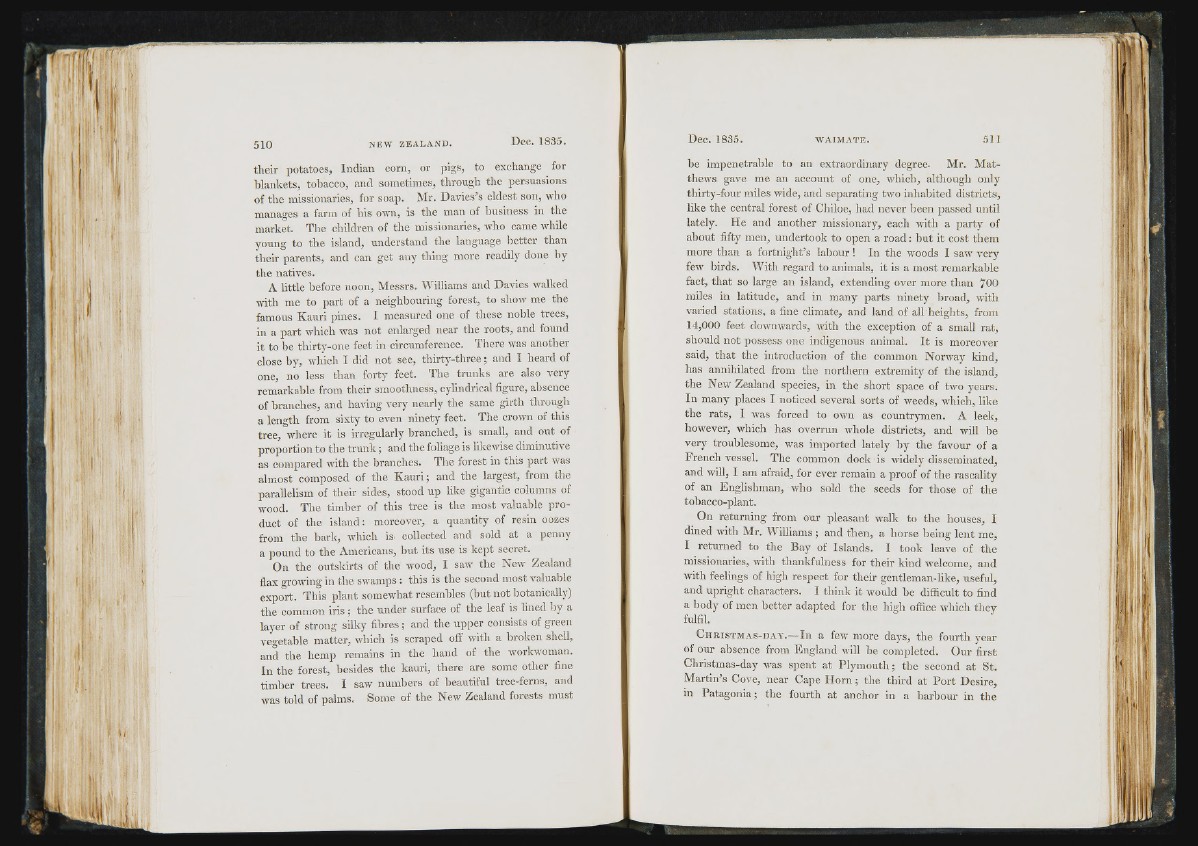
n o N E W Z E A L A N D . Dec. 1835.
their potatoes, Indian corn, or pigs, to exchange for
blankets, tobacco, and sometimes, through the persuasions
of the missionaries, for soap. Mr. Davies’s eldest son, who
manages a farm of his own, is the man of business in the
market. The children of the missionaries, who came while
young to the island, understand the language better than
their parents, and can get any thing more readily done by
the natives.
A little before noon, Messrs. Williams aud Davies walked
with me to part of a neighbouring forest, to show me the
famous Kauri pines. I measured one of these noble trees,
in a part which was not enlarged near the roots, and found
it to be thirty-one feet in circumference. There was another
close by, which I did not see, thirty-three; and I heard of
one, no less than forty feet. The trunks are also very
remarkable from their smoothness, cylindrical figure, absence
of branches, and having very nearly the same girth through
a length from sixty to even ninety feet. The crown of this
tree, where it is irregularly branched, is small, and out of
proportion to the trunk; and the foliage is likewise diminutive
as compared with the branches. The forest m this part was
almost composed of the Kauri; and the largest, from the
parallelism of their sides, stood up like gigantic columns of
wood. The timber of this tree is the most valuable product
of the island: moreover, a quantity of resin oozes
from the hark, which iS' collected and sold at a penny
a pound to the Americans, but its use is kept secret.
On the outskirts of the wood, I saw the New Zealand
flax growing in the swamps : this is the second most valuable
export. This plant somewhat resembles (but not botanically)
the common ir is; the under surface of the leaf is lined by a
layer of strong silky fibres; and the upper consists of green
vegetable matter, which is scraped off with a broken shell,
and the hemp remains in the hand of the workwoman.
In the forest, besides the kauri, there are some other fine
timber trees. I saw numbers of beautiful tree-ferns, and
was told of palms. Some of the New Zealand forests must
T i 'Vft
i l
Dec. 1835. W A IM A T E . 511
be impenetrable to an extraordinary degree. Mr. Matthews
gave me an account of one, which, although only
thirty-four miles wide, and separating two inhabited districts,
like the central forest of Chiloe, had never been passed until
lately. He and another missionary, each with a party of
about fifty men, undertook to open a road: but it cost them
more than a fortnight’s labour! In the woods I saw very
few birds. With regard to animals, it is a most remarkable
fact, that so large an island, extending over more than 7 0 0
miles in latitude, and in many parts ninety broad, with
varied stations, a fine climate, and land of all heights, from
14,000 feet downwards, with the exception of a small rat,
should not possess one indigenous animal. It is moreover
said, that the introduction of the common Norway kind,
has annihilated from the northern extremity of the island,
the New Zealand species, in the short space of two years.
In many places I noticed several sorts of weeds, which, like
the rats, I was forced to own as countrymen. A leek,
however, which has overrun whole districts, and will be
very troublesome, was imported lately by the favour of a
French vessel. The common dock is widely disseminated,
and will, I am afraid, for ever remain a proof of the rascality
of an Englishman, who sold the seeds for those of the
tobacco-plant.
On returning from our pleasant walk to the houses, I
dined with Mr. Williams; and then, a horse being lent me,
I returned to the Bay of Islands. I took leave of the
missionaries, with thankfulness for their kind welcome, and
with feelings of high respect for their gentleman-like, useful,
and upright characters. I think it would be difficult to find
a body of men better adapted for the high office which they
fulfil.
C h r i s t m a s - d a y .— In a few more days, the fourth year
of our absence from England will be completed. Our first
Christmas-day was spent at Plymouth; the second at St.
Martin’s Cove, near Cape Horn; the third at Port Desire,
in Patagonia; the fourth at anchor in a harbour in the